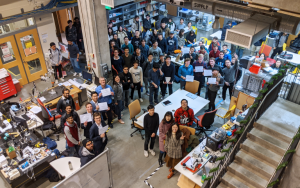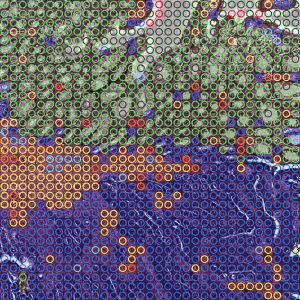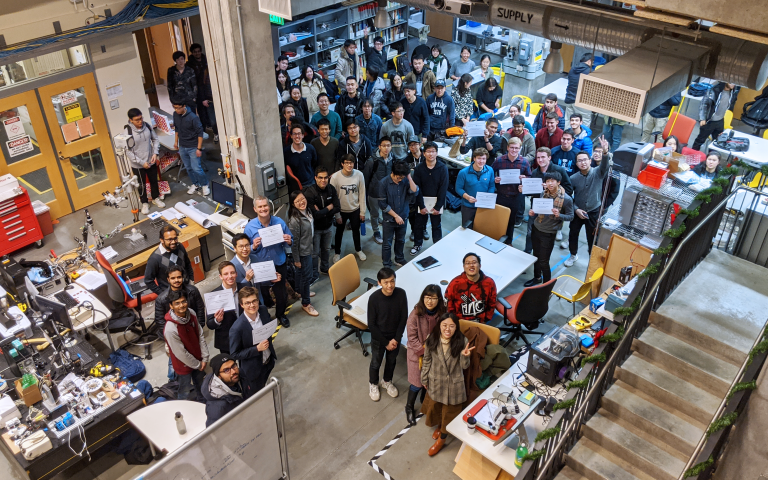Artificial intelligence (AI), under development for decades, is now hitting the mainstream. Many industries – from healthcare and banking to retail and entertainment – are eager to invest in workers who can apply AI-powered tools to solve real-world problems.

Students present final projects for Machine Learning: Deep Learning in Hackerman Hall
Johns Hopkins University now offers courses aimed at preparing students for successful careers in AI-related fields. One such course, offered by the Department of Computer Science, introduces students to deep learning, a subdiscipline of AI in which a computer tries to discover meaningful patterns from data to make decisions.
In deep learning, artificial neural networks process and learn information in a way that many argue is similar to the human brain. And much like humans, deep learning algorithms learn from experience, performing the same task over and over to improve the outcome. Directly mapping the input to the desired output makes deep learning superior to other machine learning methods when applied to complex problems related to image classification, speech recognition, and computer vision.
Everyday examples of deep learning in action include virtual assistants like Alexa or Siri and translation apps like Google Translate – and it’s how Amazon knows which products you might be interested in buying next.
If deep learning is the next frontier in artificial intelligence, Hopkins students are eager to explore the unknown. Machine Learning: Deep Learning will be offered for the fifth time this spring. Last semester, 90 students enrolled, with 70 students on the waiting list. One reason the course is popular is that it attracts students from various disciplines, according to instructor Mathias Unberath, an assistant research professor of computer science and a member of the university’s Laboratory for Computational Sensing and Robotics and Malone Center for Engineering in Healthcare.

MATHIAS project can classify cell types (including colon cancer tumor cells) in histopathological images like the above
Biomedical engineering senior Hadley VanRenterghem opted in because she knows deep learning skills are in high demand in her field.
“Machine learning has amazing potential to contribute to new advances in healthcare. I took the class because knowing how to design and apply deep learning systems is going to be very useful for my future career plans in medical technology. One big thing I learned is that there isn’t one ‘best’ model for solving deep learning problems. You have to understand the motivation and mechanisms behind different approaches,” said VanRenterghem.
Throughout the semester, students learn to design and train neural network architectures using standardized data sets. For their final project, student teams must implement a deep learning model to solve a problem of their choosing.
VanRenterghem, along with fellow biomedical engineering students Matt Figdore and Max Xu, and computer science major Taha Baig, proposed applying deep learning to improve histopathology image analysis.
Histopathologists examine human tissue samples and return a diagnosis. Automatic histopathology image recognition could speed up the diagnostic process and improve the quality of diagnosis. To this end, VanRenterghem and team built a system comprised of two deep learning models. Using a deep clustering framework, they trained the first model to group unlabeled cell images with similar features, allowing the model to classify each cell type. Their second model could then successfully identify individual cell types in tissue slide images containing multiple cell types. The team says their system (appropriately called MATHIAS, a homage to their instructor) could help histopathologists quickly identify areas that are most likely to have tumor cells.
The MATHIAS project won one of two Best Project Awards handed out by surgical robotics company Intuitive Surgical during the course’s final project demonstrations in December.
The other winning project explored training a neural network to solve jigsaw puzzles in a human-like fashion. Team members Shaoyan Pan, Matthew Pittman, Mike Peven, and Ben Killeen – graduate students in electrical and computer engineering, mechanical engineering, and computer science – were interested in how well their network could solve a puzzle of a cat. Puzzles are a popular deep learning task because the algorithm must identify reliable patterns and classify images in order to solve the puzzle.
Ultimately, the algorithm learned to solve the puzzle but performance varied depending on the content of the jigsaw pieces. Computerized puzzle pieces used for deep learning are perfectly square. Since the edges didn’t provide clues on how to solve the puzzle, the algorithm had to learn to put pieces together based only on its knowledge of what a cat is supposed to look like. This was challenging for the computer if, for example, several puzzle pieces only showed fur.
“We wanted the model to emulate unsupervised learning when solving the puzzle – to make decisions based on context clues much like humans do. That way, our model can perform different tasks that involve object recognition, rather than just one specialized task. The next step would be to test the model on other datasets and see how it works,” said Peven.
Developing a deep learning course can be tricky because the field moves so quickly, says Unberath. He wants his students to understand AI’s potential impact on society, not just its technical concepts. For example, Unberath has added a new lecture to the syllabus called Ethics, Fairness, and Human-Centered AI.
“We cover the basics in the first half of the semester, but then we start to talk about issues I think more creative minds should be considering: How can we learn from unannotated data? How can we detect and deal with bias in the data? And most fundamentally, which open problems can we tackle with learning-based algorithms to promote a fair and equitable society? Discussing these topics in class seems to resonate very well with our students.”
